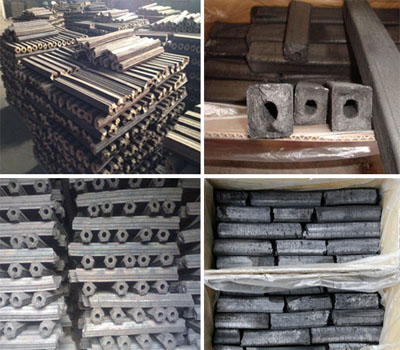How to measure the quality of charcoal?
The charcoal produced by biomass briquette machine and carbonizing furnace has different quality index for different purposes. We usually measure the quality of charcoal based on the moisture content, volatility, ash content, the fixed carbon content and the calorific value of charcoal.

1. The carbon content of charcoal
The carbon content of charcoal changes with the variety of raw materials and carbonizing temperature. Generally speaking, the carbon content of hardwood is higher than the cotton wood and fortune paulownia wood with lower density under the same carbonizing temperature.
The carbon content of machine made charcoal made from the same raw material is higher with high carbonizing temperature. Taking pine as an example, when the carbonizing temperature is 380℃, its carbon content is 76%; when the temperature reaches 500℃, the carbon content is 85% and when the temperature up to 600 ~ 700℃, the carbon content is 92%.
2. The moisture content
Since charcoal is a highly absorbent substance, it absorbs moisture from the air during the stacking process and increases its moisture content. Therefore, the water content of charcoal has no effect on its own quality, but client often requires lower water content of charcoal to improve its economic value. In general, the moisture content of charcoal is less than 3% after discharging from the carbonizing furnace.
3. The calorific value
It refers to the energy released by per kilogram of charcoal in a specific condition and expressed in kilocalorie. The calorific value of charcoal is directly related to the thermal insulation time of carbonizing temperature. In the same carbonizing temperature and heat preservation time, the charcoal calorific value of different raw materials are different. Generally speaking, high carbonizing temperature and long heat preservation time would lead to high carbon content and calorific nature. When the carbonizing temperature is lower than 450℃, the calorific value of charcoal made by wood and its leftover material is usually between 6500 ~ 7000kcal/kg, and the calorific value of straw and rice husk charcoal is commonly 6000kcal/kg. When the carbonizing temperature is higher than 600℃, the calorific value of charcoal made by these materials can be improved by 500 ~ 1000kcal.
4. The ash content
Ash is the remaining white or pink substance after all the charcoal is burned. It directly affects the use and economic value of charcoal. For example, the ash content of straw, rice husk and other substances is large, and it is not easy to fall off when burning, resulting in low temperature when burning, which is not suitable for making live and industrial charcoal. Of course, people want the ash content of charcoal to be as small as possible to expand its use.
The ash of charcoal varies with the process of carbonizing and temperature. But as for wood or the leftover material, the ash difference after carbonizing is small. Generally speaking, the ash content of charcoal made by broad-leaved forest is higher than coniferous forest in the same condition. The ash content of charcoal made of raw materials with large bark proportion is higher also. The usual ash content of charcoal is 1 ~ 4 percent.
5. volatility (volatile content)
The content of volatile depends on the carbonizing temperature of machine made charcoal. According to different uses, we can make low, medium temperature charcoal, also high temperature charcoal.
The content of CO, CO2, H2, CH4, gaseous carbohydrate and other volatiles that the former releases in high temperature calcining is generally 12 ~ 20%. The above volatilization of high temperature charcoal is less, and its content is generally less than 5%.

